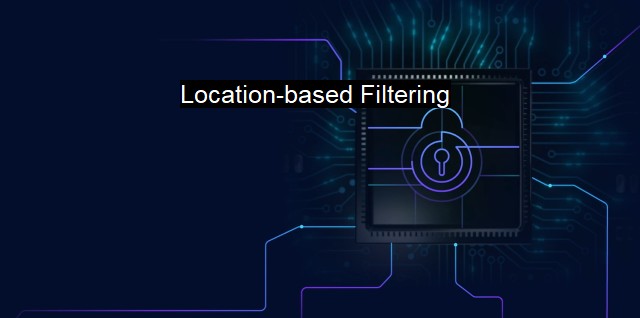What is Location-based Filtering?
Enhancing Cybersecurity with Location-Based Filtering: A Guide to Protecting Networks Against Malware and Online Threats
Location-based filtering is an advanced network security mechanism predominantly used in cybersecurity and antivirus applications. It is a technologically advanced method predicated on restricting or allowing data transmission based on policy-defined geographic locations. It is primarily based on defined content, performance, or security blocking parameters that regulate the flow of data across computer networks.Location-based filtering operates on IP address geolocation data, which is based on internet protocol addresses. Each IP address carries location information about the origin of traffic. Thus, it becomes viable to identify the physical location of any specific data point. This information is primarily used to filter network accessibility based on any device's origin or destination location. An IP address’s geographical data generally encompasses details like the country, region, city, postal code, and longitude/latitude coordinates. In some advanced mapping inputs, it may also illustrate the Internet Service Provider (ISP).
Location-based filtering thereby performs a pivotal role in cybersecurity functions. One of the key security benefits location-based filtering offers revolves around filtering out web traffic from entire countries known for hosting cybercriminals. This works on the general principle of precluding unnecessary risks by totally disallowing access from locations associated with widespread malware and other cybersecurity threats.
Specific industries might be subject to data privacy laws and regulations that forbid the transferring of sensitive data over specific geographical boundaries. Through location-based filtering, firms can automatically prevent data breaches, thus adhering to compliance requirements. This tool can also be instrumental in identifying false positives by thwarting data flows that do not typically conform to geographical patterns observed in the past.
Antivirus software also benefits from location-based filtering. Certain regions show a more significant prevalence of certain forms of malware. In such scenarios, location-based filtering can enhance malware detection rates. For instance, antivirus software could use the method to up-scale scanning and detection processes for IP addresses located in regions known for specific malware types.
It also aids in creating algorithms that identify and classify behaviors and activities related to a specific location. For instance, repetitive attempts to access a network from an unknown or low-trust location could lead to that location getting flagged, triggering relevant systems to scrutiny the associated activities.
This method also supports the use of content delivery networks (CDN). CDNs use geolocation to route network traffic to the nearest severing instance to minimize latency. They can be used in tandem with location-based filtering to firewall the delivery of certain types of content to specific geographic areas.
One of the significant potential drawbacks of location-based filtering is the possibility of producing false positives due to inaccurate geolocation databases, or VPNs and proxies that can hide or manipulate a user's true IP location. Also, sometimes legitimate users may unexpectedly find themselves locked out of necessary internet services.
It can present issues with user experiences and accessibility as well, as content might be available for a user in one location but not when they're visiting somewhere else. While location-based filtering definitely improves data privacy, cybersecurity, and reduces the exposure to malware and harmful threats, it also necessitates diligent management to ensure it balances both security and user experience.
Location-based filtering portends a useful tool in a security practitioner's repertoire. Whether explicitly combating cyber-attacks that originate from specific geographical locations or enhancing threat identification by antivirus programs, location-based filtering serves as an invaluable utility. like almost every technology, location-based filtering comes with its unique set of advantages and potential pitfalls, which further necessitates a balance between extreme vigilance and ensuring seamless user experience.

Location-based Filtering FAQs
What is location-based filtering in cybersecurity?
Location-based filtering is a cybersecurity technique that involves setting up restrictions or permissions based on the geographical location of the user or device. It can be used to block access to certain websites or online services from specific countries or regions, or to allow access only from trusted locations.How does location-based filtering help with antivirus protection?
Location-based filtering can help prevent malware attacks by blocking or restricting access to websites or sources of malware that are known to originate from specific regions. It can also be used to enforce stricter security policies for devices that are located in high-risk areas, such as public Wi-Fi networks or countries with higher rates of cybercrime.Can location-based filtering be bypassed by hackers?
Location-based filtering can be bypassed by hackers using techniques such as VPNs or proxies that can mask the location of the user or device. However, implementing multiple layers of security measures, such as combining location-based filtering with other authentication methods or advanced threat detection technologies, can make it more difficult for hackers to penetrate the system.What are the potential drawbacks of location-based filtering?
Location-based filtering can be over-restrictive, potentially blocking legitimate traffic from users who are not located in approved regions or who are using VPNs for privacy reasons. It can also create additional administrative overhead for managing and updating the geographic whitelist or blacklist. Therefore, it's important to balance the benefits and risks of location-based filtering and implement it with careful consideration and testing.| | A | | | B | | | C | | | D | | | E | | | F | | | G | | | H | | | I | | | J | | | K | | | L | | | M | |
| | N | | | O | | | P | | | Q | | | R | | | S | | | T | | | U | | | V | | | W | | | X | | | Y | | | Z | |
| | 1 | | | 2 | | | 3 | | | 4 | | | 7 | | | 8 | | |||||||